Many exercise programs target a single fitness variable, improving only that aspect of fitness. The demands of scuba diving, however, include varying combinations of muscular strength, muscular endurance, power, cardiovascular endurance and flexibility. Interval training is effective for simultaneously improving all these fitness variables for a safer and more comfortable scuba experience.
Your muscular strength will increase as you move your body weight in a controlled manner through the exercises presented here. Muscular strength is important for lifting yourself and your gear before and after diving.
The more repetitions you complete, the more your muscular endurance will improve, reducing muscles’ recovery times. Rather than taking a breather after donning your gear, you’ll be able to get right into the water.
As you increase the speed of your movements and launch off the ground during the squat push, you will improve your power — the work you can do in a given period of time. Improved power is particularly beneficial in diving when climbing a ladder or entering or exiting the surf.
Maintaining an elevated heart rate throughout the workout will improve cardiovascular endurance, which is how efficiently your heart and lungs deliver oxygen to the rest of the body. Interval training has been shown to be highly effective at improving cardiovascular efficiency. As you decrease the amount of rest time between sequences (toward a goal of no rest), you will increase cardiovascular endurance. This allows your body to operate at a lower percentage of its maximal capacity, leaving a greater reserve for any challenging conditions that arise.
The exercises shown here have the added benefit of enhancing flexibility, one of the most frequently neglected components of fitness. In addition to improving your range of motion (ROM), added flexibility leads to a reduced risk of injury. In diving, flexibility comes into play while wriggling into a wetsuit, reaching for a tag line or untangling hoses.
Interval training also burns calories. Your body is constantly working hard as specific muscle groups alternate between work and rest. When one group of muscles is actively working, other groups are recovering. This is a challenging workout without any breaks, but each sequence is only four minutes long with a 30-second calf stretch at the end for recovery.
Note: To avoid an increased risk of decompression sickness, DAN® recommends that divers avoid strenuous exercise for 24 hours after making a dive. Always make sure that you have medical clearance to exercise during your annual physical exam or following any changes in your state of health.
Exercise Direction
Focus on maintaining a full ROM and proper form while completing each exercise; quality is much more important than quantity in any workout. As you progress, increase the number of repetitions in each 30-second exercise, and try to work up to three sequences.
Sequence(30 seconds each):
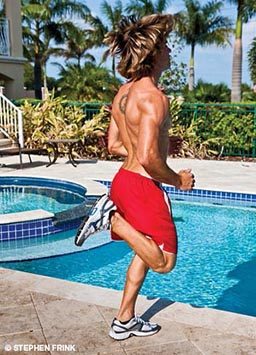
- Butt kicks (lower intensity)
- Squat push (higher intensity)
- High knees (lower intensity)
- Squat push (higher intensity)
- Frankensteins (lower intensity)
- Push-ups (higher intensity; slow)
- Mountain climbers (higher intensity; fast)
- Calf stretch (recovery)
- Repeat as you can.
Butt Kicks (Lower Intensity)
Butt kicks will strengthen your hamstrings while stretching your quadriceps.
- Butt kicks can be done in place or traveling across whatever space is available.
- Alternate trying to bring each heel all the way to your buttocks.
- Start at walking speed, and gradually increase speed without sacrificing ROM.
Squat Push (Higher Intensity)
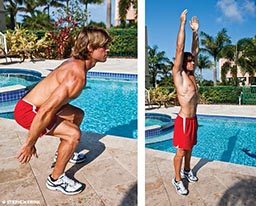
The squat push will work your entire body, focusing on power.
- Start with feet shoulder width apart, shoulders back and head up.
- Swing your arms back while sitting your buttocks back.
- When your thighs are nearly parallel to the ground, swing your arms forward and up while extending your hips, knees and ankles.
- Do not leave the ground at first; just get up onto your tiptoes.
- When and if your joints are comfortable, repeat, launching straight up off the ground.
High Knees (Lower Intensity)
High knees will strengthen your hip flexors, stretch your gluteals and hamstrings, and improve your balance.
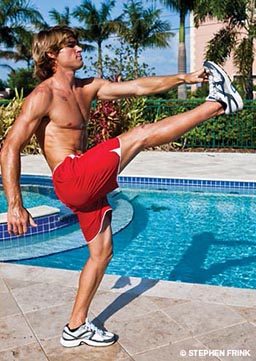
- Lift your knee as high as it can go.
- Then, and only then, hug the knee toward your chest; alternate.
Frankensteins (Lower Intensity)
Frankensteins also strengthen your hip flexors and quadriceps, stretch your hamstrings and gluteals, and improve balance.
- Maintain an upright posture with chest and head up.
- Bring your right leg up to touch your left fingertips; alternate.
Tip: Try to keep your fingertips at shoulder level.
Push-Ups (Higher Intensity)
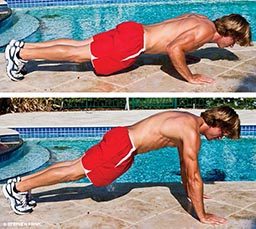
Push-ups build muscular strength in the pectoralis major, tricep and anconeus muscles. Your abdominals and lower back will build muscular endurance as they stabilize your body.
- Start in plank position with hands under your shoulders.
- While keeping your spine in a neutral position (no sagging back or elevated buttocks), flex your elbows until your upper arms are horizontal to the ground.
- Don’t worry if you can’t get your arms all the way horizontal; you will get a little further with each workout.
Mountain Climbers (Higher Intensity)
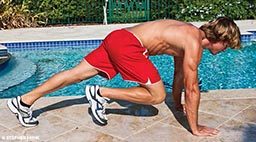
Mountain climbers are designed to improve upper-body strength and endurance while increasing power and speed in the lower limbs.
- Start in plank position with hands directly under the shoulders as with the push-up.
- Bring your knee to your chest, placing your foot on the floor under your chest; alternate.
Tip: Start slowly, making sure to bring your knee and foot as far forward as possible. Each time you complete the workout, your speed and ROM will naturally increase.
Calf Stretch (Recovery)
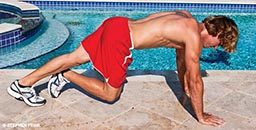
Stretching the calves (an area prone to cramping during finning) is particularly important after completing these exercises. Calves are accustomed to walking, but the power involved in the squat push and mountain climbers can be stressful.
- While supporting your weight on your hands in the mountain climber position, alternate pressing each heel toward the floor.
- The leg of the calf being stretched will support most of your weight during this exercise.
© Alert Diver — Q3 Summer 2011